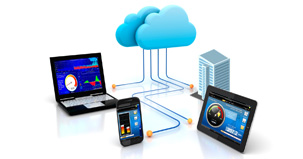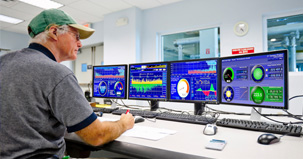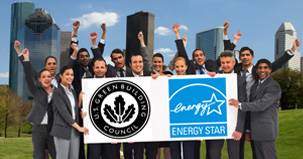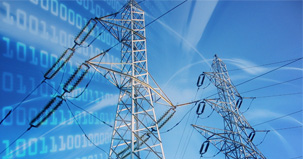- Home
- Smart Data
Smart Data
Actionable intelligence on energy and water use:
- Helps users identify inefficencies, and waste
- Provides real-time feedback on conservation
Right data for the right audience:
- Facility managers identify when and where energy is wasted
- CFO's can track and verify financial savings from initiatives
- Company knows its carbon and water footprint
Related Products
 Information any time, anywhere
Information any time, anywhere - Smart User
Smart User
Smart users leverage real-time data and reduce energy and water use by:
- Continuously identifying opportunities
- Acting on opportunities
- Tracking and verifying savings
- Sustaining savings
Related Products
 Monitor, Manage, Maintain
Monitor, Manage, Maintain - Smart Community
Smart Community
A smart community is one where all stakeholders are engaged in energy and water conservation. A smart community can be achieved by:
- Showing people precisely how much they are using
- Providing real-time feedback on conservation actions
- Effectively communicating efficiency results
Related Products
 Communicate and Conserve
Communicate and Conserve - Smart Grid
Smart Grid
Smart grid, as we define it, is a "green grid", with efficient resource use and the key to a low-carbon future. We help our customers prepare for the smart grid by:
- Engaging users with smart data
- Enabling smart users to increase resource efficiency
- Educating & empowering smart communities
Related Products
 Smart grid and a smarter future
Smart grid and a smarter future - Smart Buildings
Smart Buildings
Smart buildings maximize resource (energy, water, capital) efficiency. These buildings are optimized using energy and water management process with high data visibility which lead to reduced energy and water spending.
- Higher operating income and higher asset values for owners
- Increased productivity for occupants
- Lower carbon footprint for the community
 Resource efficient buildings
Resource efficient buildings
Recent Posts
Leaky Pipes?
Proactive Technologies Make It Easy to Conserve Revenue & Non-Revenue Water
You turn on the faucet, the shower or the hose and it’s there. You bathe in it. Drink it. Swim in it. Water use has increased six times worldwide since the turn of the 20th century. However, during the same 111 years, the human population has only quadrupled.
Huh? Either people have gotten thirstier and dirtier or there is a major problem. Unfortunately, it’s the latter.
It’s almost impossible to imagine – because we take the availability of water for granted – but, according to research conducted by the United Nations, nearly half the world’s population will be dealing with significant water shortages by 2025!
Do we add this statistic to the pile and burrow our heads farther into the sand? Of course not because, it is possible, as individuals, or even communities, to really have an impact on natural resources. Like anything else, knowledge is power.
First off, clean, usable water falls into two categories known as revenue and non-revenue water. Revenue water is the water that utility companies make money on once it has entered a house or business. When you turn on the taps and the water meter starts running, the utility company is raising revenue. Non-revenue water, on the other hand, is what’s flowing through the underground, generally “unseen” water infrastructure, pipes and sewers. It stands “at the ready,” but it’s not being paid for yet.
Both revenue and non-revenue water are being wasted at alarming amounts around the world. Whether your bathtub spigot drips or the underground pipe is cracked, water leaks are a wasteful reality that is having an urgent impact on the world’s water supply.
Get on Board
Did you know that the average American uses 99 gallons of water each day? Look, while experts in water conservation may suggest shorter showers, low-flow toilets and other techniques to save water, no one is suggesting a complete moratorium on water use. It’s about being thoughtful, smart.
That’s where Noveda Technologies’ real-time water monitoring system comes into play. Through this system, total water use can be monitored by an easy-to-use online dashboard. By utilizing Noveda’s software to measure and monitor water usage, homeowners and business owners, alike, are able to see how much water is being used, and cut water bills by 15 percent on average, by scaling back unnecessary or excessive water use.
Noveda Technologies, based in Branchburg, N.J., recently teamed with Israel-based Aqua-Rimat, a Rimat Group Company, to offer customers an integrated real-time water management and leak detection platform, based on Aqua- Rimat’s patented Leak Buster technology. As the name indicates, the integrated platform detects and controls water leaks, all in real-time.
Leak control operates on a constant basis, so that any problem is immediately detected, controlled, and reported so that it can be fixed. The system also allows customers to analyze the real-time water usage data against the standards of prior usage. In addition, customers can get real-time alerts sent via text or email to keep them informed about water usage and leaks in their homes or offices.
With real-time monitoring and leak detection, combined with control coming in one-minute intervals, the Noveda system seeks to cut back on revenue water loss by putting the power in the peoples’ hands.
“We are very pleased to partner with Rimat, especially as we look to expand globally,” said Govi Rao, president and CEO of Noveda Technologies. “While Noveda's expertise lies in real-time monitoring and advanced context development through visualization, Rimat's innovative team has developed proprietary technologies in active water-leak detection and monitoring that are world-class. With our combined capabilities, we will be better positioned to lay the foundation for the advancement of real-time water leak detection and monitoring solutions.”
The Other Side of the Coin
Let’s assume that every person around the planet puts into place a water monitoring system to cut down on usage and reduce water bills. That would go a long way to solving the “revenue water” crisis. (Though, water companies would likely not be happy with the outcome of that initiative!)
That still leaves a serious problem on the table. The waste of non-revenue water, thanks to an ever-aging pipe infrastructure, increases exponentially with every cracked pipe.
There are several old-fashioned solutions to conserving non-revenue water, ones that have been around for decades. Consider Atlanta’s solution: the city recently commenced a $4 billion plan to repair existing waste and drinking water networks. The city now has the highest water bills in the country. Philadelphia replaces 20 miles of water main piping every year.
This repair and replace strategy that costs taxpayers more than they can possibly afford, just isn’t working. The fact is, even as Philadelphia keeps up its annual capital improvement projects, the city has 3,300 miles of water mains! At the rate of 20 miles per year, it will take 160 years to overhaul the entire system of pipes.
Further, statistics don’t lie. It is estimated that wasteful practices around the world, combined with leaky pipes, combine to fritter away a total of $15 billion in world funds per year. On average, cities in the developed world lose 10 to 30 percent of their drinking water supply to pipe leakage. That’s enough water enough to supply 200 million people!
New technologies are required to help address the issue of wasted water.
Israel-based TaKaDu launched software that enables people to locate water system dysfunctions with precision. Customers, like the City of London, are able to use TaKaDu’s technology to prioritize repairs and track completion.
It does this by collecting data from all the existing water meters in the system, which allows it to pinpoint where the leak or drip is coming from before the problem gets out of control. This system effectively conserves non-resource water, and is without a doubt a step in the right direction, according to British utility companies.
In fact, hundreds of megaliters of water are being saved every day in London, where the TaKaDu system monitors 10,000 miles of pipes serving 75 percent of the population. This means that millions of British pounds are being saved every year.
Another intriguing troubleshooting technology comes courtesy of startup Redzone Robotics. As the company’s name indicates, it deals in pipe-repairing robots. These robots are equipped with an arsenal of instruments, including an instrument called Lidar (Light detection and ranging), which generates a 3D profile of the pipe’s interior. In this way, the robot can precisely locate the problem area. Not restricted by a human’s anatomical limitations, these robots can get at almost any section of a water system autonomously.
Certain utilities in the United States are also working with Leak Detection Systems (LDS), which display the pertinent data to the pipeline controller, and alarm the controller when a leak emergency—which can be disastrous—occurs. Internally based systems monitor flow, pressure, and fluid temperature in an effort to keep an eye on internal pipeline parameters, which are then used to locate a leak.
Established Brands, New Initiatives
Big business is increasingly jumping aboard the non-revenue water conservation train. IBM teamed with the Nature Conservancy, in an effort to protect freshwater resources. Big Blue’s technologies are now being used to understand the impact of human intervention on river basin ecosystems. At the same time, General Electric is actively involved in designing water reuse solutions, as well as water purification technologies, as part of their Ecomagination initiative.
Water that has previously been used for waste can be purified and repurposed, possibly even becoming revenue water again. It’s an idea that might be tough to get your head around at first, but this is surely part of the solution – according to both electronic appliance company LG and Siemens Water Technologies. Both companies have unveiled technology designed to disinfect and repurpose wastewater.
With the abundance of new ideas coming from both established and new companies, there is no reason to fall back on the old methods for keeping track of the world’s water supply. These new solutions are crucial to optimizing water usage.
Both revenue and non-revenue water can be monitored and conserved efficiently, if we, as a society, are committed to today’s technology solutions. When you consider the statistics surrounding wasted water and predicted shortages, it seems the choice is fairly clear. We can pay attention to the appalling waste of water and act now to stop it. Or, we can take a wait and see what happens if we don’t.
Originally published in greenbuildingspro.com



